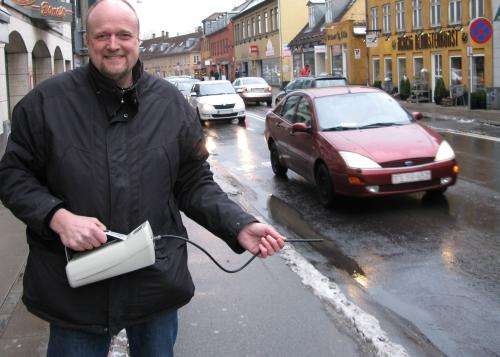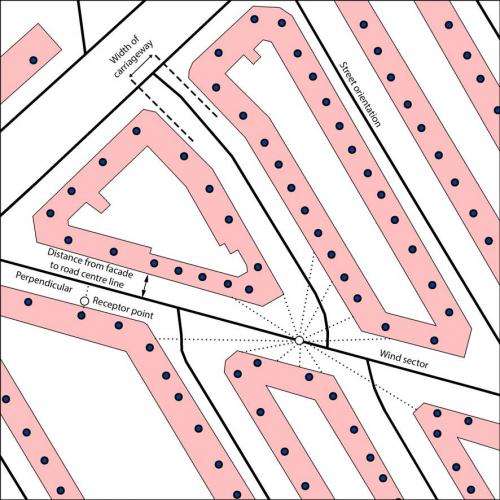More diseases from air pollution uncovered by improved data material

Good health and personal registers in combination with model calculations of air pollution down to an individual address has helped Danish researchers to become among the very best in the world to detect harmful diseases deriving from polluted air.
At rest, we breathe approximately 12-15 times per minute, and for each inhalation we change approx. one litre of air. Depending on the activity level, this makes up a daily quantity in the order of twenty cubic metres of air that - with its content of pollution in the form of particles and different gases - can make us ill depending on how polluted the air is.
Asthma attacks, wheezing, cardiovascular diseases and lung cancer are some of the more glaring examples of diseases we - in worst case - can get from the domestic air. The list of injuries due to air pollution in Denmark is long. This appears from a brand new article that professor Ole Hertel from Aarhus University, has written with a number of Danish colleagues at University of Copenhagen, the Danish Cancer Society and Aarhus University. "So the list of diseases detected in Denmark is long, but it does not mean that we have the world's most polluted air. This is to be found in Asia, Africa and South America. Here, you typically find a yearly mean value of the particle pollution (PM10) of 50-200 micrograms per cubic metres of air, while the content in Copenhagen and other Western European Megacities typically is at a lower level - about 20-50 micrograms per cubic metre. But even in a "moderately polluted" air as we call it in Danish towns and cities, we find many serious injuries which come from the air that we breathe every day," explains Ole Hertel.
Danish studies
In the article "Utilizing Monitoring Data and Spatial Analysis Tools for Exposure Assessment of Atmospheric Pollutants in Denmark", Ole Hertel and his colleagues review the Danish experiences in combining measurements and models. By combining measurements on relatively few but well-chosen places with advanced models for spreading of air pollution, the researchers can calculate the air pollution down to the individual addresses.
Hertel and Co. review a number of Danish studies of the coherence between air pollution and injuries to health. A total of nine short-term studies have been published in Denmark, where researchers have demonstrated respiratory and cardiovascular diseases after episodes with increased air pollution, etc. Similarly, eleven studies demonstrate long-term injuries due to air pollution, e.g. lung cancer, cardiovascular diseases, diabetes and mortality.

Improved information
The scientists' ability to detect a wide range if different types of damages of the Danes' health is due to the fact that Danish researchers represent some of the very best to demonstrate illnesses caused by air pollution on human health. This is obvious when we look at the model for spreading of air pollution, OSPM, which was developed by Danes and is now used in approx. twenty countries. This is also why Ole Hertel was invited to give an overview of the diseases detected to be a consequence of the air pollution in Denmark, first on a major international conference and afterwards in book form:
"We have some very unique health registers in Denmark and that is quite different from other countries. We are able to connect addresses and health registers with air-polluted areas. In Denmark, we have many cohort investigations where the same persons are followed during a long period of time. Here, we can link to other sorts of information and thus separate effects related to e.g. lifestyle from effects related to air pollution. For instance, the Danish Cancer Society makes a study of people's diet and exercise habits in a so-called Diet, Cancer, Health study, and in addition you have the whole birth cohort where the same children have been followed from around the turn of the century until now," explains Ole Hertel.
But not only do we have some of the world's best health registers in Denmark;
"We also have some outstanding good pieces of information on traffic, buildings and infrastructure. This information we have concluded in the so-called
AirGis Model which uses digital road maps and building and road registers to determine the parameters we need for air quality calculations on address level. Therefore, we can come up with conclusions that are more precise than in other countries." Ole Hertel emphasises that there are strong constrains around handling of personal information.
Surprising results
Ole Hertel points out one of the Danish results as particularly notable:
"It came as a surprise to me that the studies showed a connection between air pollution and diabetes. It is rather new information that air pollution can cause diabetes, and we are working on finding a biological explanation for this correlation. This is an example of the fact that our very detailed way of working in Denmark leads to precise results."
It takes fifty litres of air to read this article
Dear reader, if you represent an average reader, you have just spent three minutes and 58 seconds to read this article - probably inclusive of pauses for thoughts (thank you for that!). During this time you have inhaled approx. fifty litres of air through your lungs, depending on your gender and size.
More information: Utilizing Monitoring data and Spatial Analysis Tools for exposure Assessment of Atmospheric Pollutants in Denmark, Hertel, O., etc. 2013. In: Occurrence, fate and Impact of Atmospheric Pollutants on Environmental and Human Health; rapporteur: Mr McConnell, L. etc. AC union areas Symposium Series; American Chemical Society: Washington, DC. DOI: 10.1021 /BK-2013-1149.ch006 , p. 95-122.














